
- INSIDE
- Development of fire-inhibiting
non-flammable gel polymer electrolyte for LIBs
본문영역
Development of fire-inhibiting
non-flammable gel polymer electrolyte for LIBs
Professor Song Hyeon-gon, Department of Energy and Chemical Engineering
As the climate crisis and carbon neutrality issues grow, the supply of electric vehicles (EVs) continues to increase. Encountering EVs in apartment complexes or buildings' underground parking lots has become a common occurrence. However, if there is something to worry about as the spread of EVs increases, it is battery fires. This is because, if handled incorrectly, it could lead to uncontrollable accidents. Professor Song Hyeon-gon's research team therefore developed groundbreaking technology to help resolve such battery fires.

Electric vehicle batteries, now is the time to focus on safety
To start a fire, fuel (e.g. firewood), energy, and oxygen are required. Currently, batteries usually consist of a cathode material, a separator, and a liquid electrolyte. Since the liquid electrolyte is organic and the separator is a polymer, it catches fire easily. In addition, oxygen is already included in the cathode material, and when the battery overloads and generates heat, energy is also secured. In addition, in order for fire to spread significantly, a chain reaction of radicals (an atom or molecule with one electron, which is characterized by being very unstable) is required; and this reaction is easily accomplished inside of liquid electrolytes. In other words, if the battery temperature rises rapidly due to various circumstances, a fire can easily break out and spread.
“Among the movies from the 1970s, there was one called ‘The Towering Inferno.’ It's a disaster movie about a major fire occurring due to an overvoltage short circuit in the world's tallest skyscraper. Imagine that the 1st to 3rd floors of a large building's underground parking lot are all filled with electric vehicles. If a fire breaks out in just one EV, numerous electric vehicles could explode in succession like bombs, causing unimaginable damage.”
Professor Song Hyeon-gon emphasized that it is very important to research and produce fire-resistant batteries prior to the expansion of EVs. So far, the battery field has focused on having good specifications. All we have focused on is efficiency, allowing EVs to run longer and faster on a single charge. However, batteries now also require safety in addition to efficiency. The world's leading companies are also focusing on battery safety and formulating new strategies.
Various researches have already been conducted to create batteries that are fire resistant. Most of them chose to mix excessive amounts of flame retardant additives with liquid electrolytes, or use solvents with very high boiling points. However, existing methods had the problem of drastically reducing the ionic conductivity of the electrolyte, thereby reducing battery efficiency. In this situation, the recent achievements of Professor Song Hyeon-gon's research team shine even more brightly.
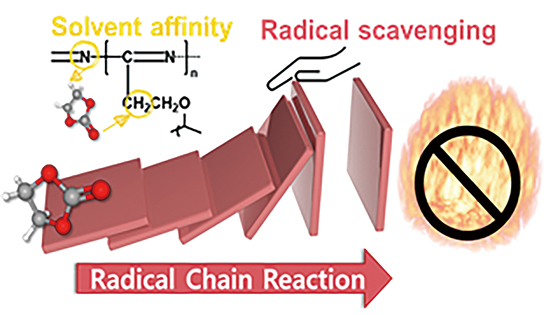
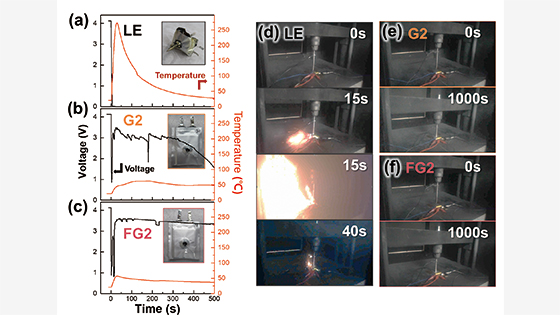
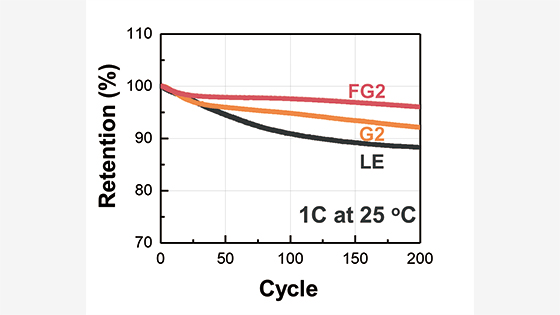

Battery with two characteristics of ‘flame-retardant’
Professor Song Hyeon-gon worked with the research team of Dr. Jeong Seo-hyeon of the Korea Research Institute of Chemical Technology's Fine Chemical Research Center, and Dr. Tae-hee Kim of the Korea Institute of Energy Research's Ulsan Next-Generation Battery Research and Development Center. Together they developed a 'non-flammable polymer semi-solid electrolyte' that does not burn. This drew attention as a research achievement that can effectively suppress electric battery fires, and was selected as the cover story of ACS Energy Letters, a prestigious academic journal in the energy field, and published online on October 13. In relation to this, five domestic and two overseas patents have been applied for. Major battery-related companies such as LG Energy Solutions and Samsung SDI are also showing great interest.
“Flame retardancy can be viewed in two ways: a material that is not easily flammable in itself; or a material that acts as a fire-extinguishing agent by affecting other parts that burn. The non-flammable polymer semi-solid electrolyte developed this time is characterized by possessing both of these properties.”
Professor Song Hyeon-gon's research team has been researching semi-solid electrolytes since 2013. A semi-solid is a mixture of liquid and solid, and has the fluidity of a liquid, but is held in a solid mesh structure and maintains its overall shape. It is easier to understand if we think of the jelly we commonly eat. The research team created a polymer semi-solid electrolyte by adding a small amount of polymer to the liquid electrolyte. And research has been conducted to provide various functionalities. The non-flammable polymer semi-solid electrolyte developed this time is effective in preventing fires by suppressing the fuel and radical chain-reactions necessary for the combustion process.
“Flame retardancy was not studied from the beginning. About three years ago, however, researcher Jeong Ji-hong, the first author of this paper, became interested in flame retardancy, and began burning the materials he had been working with. But then we discovered that the semi-solid materials we had developed thus far were fundamentally resistant to fire. In order to add reliable flame retardancy, polymer synthesis and field testing were necessary — but since we were an electrochemical laboratory, there were many difficulties. So we chose to collaborate with research centers located in Ulsan.”
Professor Song Hyeon-gon's research team visited the Korea Research Institute of Chemical Technology's Fine Chemical Research Center with the idea of attaching molecules that would act as fire extinguishers to the semi-solid material they had developed, which basically has the characteristic of being fire-resistant. And it was tested at the Korea Institute of Energy Research's Ulsan Next-Generation Battery Research and Development Center to see whether the synthesized results could withstand various extreme situations. Thanks to the three organizations exerting their respective capabilities and creating synergy, world-class results were finally achieved.
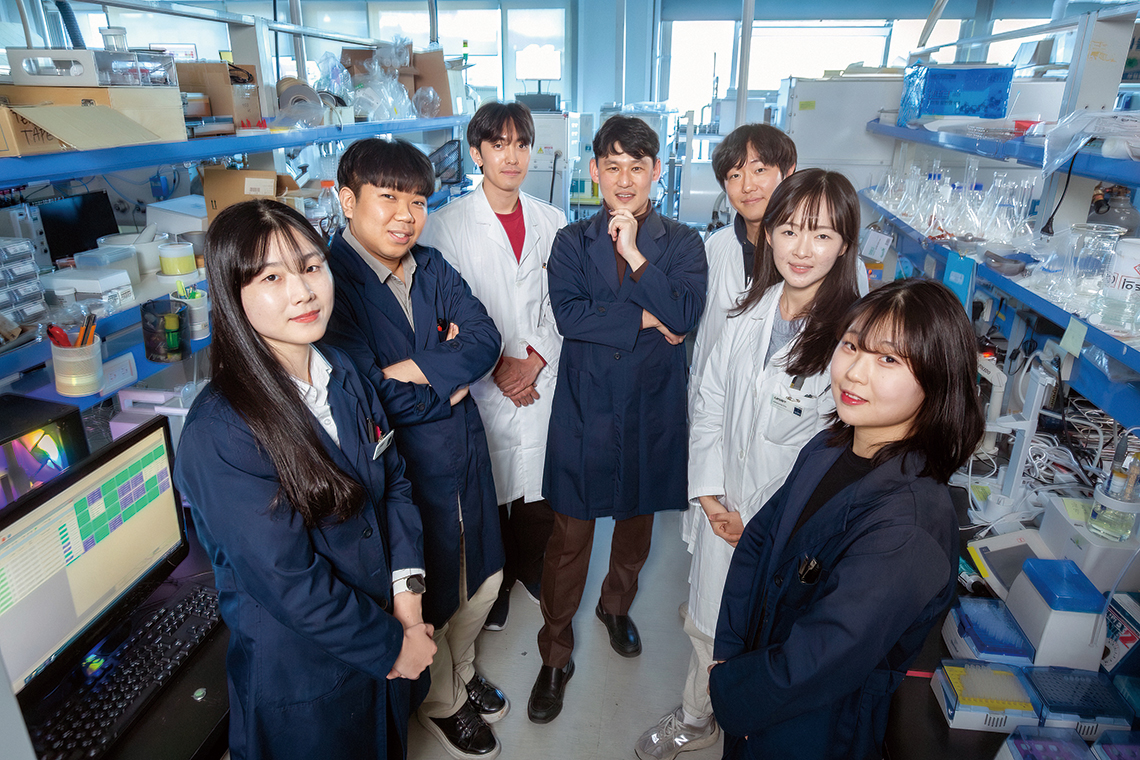
- Professor Song Hyeon-gon's research team, which is researching batteries that maintain efficiency and safety even in extreme temperatures and situations, developed a 'non-flammable polymer semi-solid electrolyte' to suppress battery fires
-
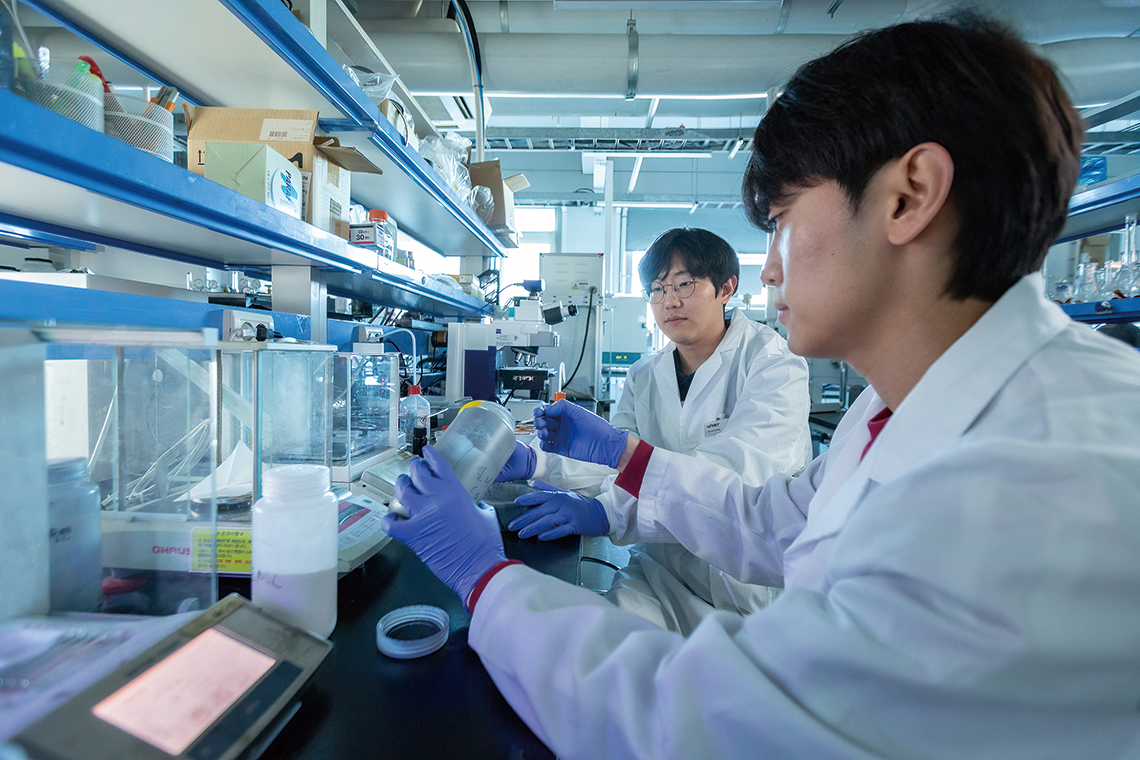
The research team created a polymer semi-solid electrolyte by adding a small amount of polymer to the liquid electrolyte.
Can be directly applied to existing battery-assembly processes
However, no matter how important the safety of the battery is, it is useless if its efficiency drops significantly. The non-flammable polymer semi-solid electrolyte developed by the research team showed a lithium-ion conductivity (4.8 mS/cm) that was 33% higher than that of existing liquid electrolytes. In addition, in the case of the pouch-type battery made using this, it was confirmed that the lifespan was improved by 110% compared to ordinary batteries.
“The efficiency of a battery is directly related to its ionic conductivity. If a flame-retardant material is added to the liquid electrolyte as in previous studies, approximately 30% of the material must be replaced with a flame-retardant material. Of course, the ionic conductivity will inevitably drop accordingly. The non-flammable polymer semi-solid electrolyte developed this time has many advantages. By adding only 2 wt% of polymer material to the existing liquid electrolyte, sufficient lithium ion conductivity can be secured, and it can also be directly applied to the existing battery-assembly process.”
Currently, Korea has the world's best technology in the field of lithium-ion batteries. However, China, Europe, and the United States are following closely behind. Although it is not easy to implement the highest specifications while also taking care of safety, it will be a great advantage in strengthening Korea's competitiveness in the battery market.
Professor Song Hyeon-gon led the ‘Electrochemical Laboratory for Advanced Technology (ECLAT)’ and decided on the concept of ‘Between coolness and passion.’ This is because the research is conducted separately into high-temperature and low-temperature sessions. The development of this non-flammable polymer semi-solid electrolyte corresponds to the high-temperature session. Representative research in the low-temperature session is the batteries that can be used even at minus 30 to 50 degrees Celsius. The research team is focusing on developing the so-called ice electrolyte. In addition, research on electrolysis catalysts, which are decisive for hydrogen energy production, is also in progress. The point of differentiation is the overlapping activation using the main catalyst and sub-catalyst. Research on zinc ion batteries, one of the next-generation batteries, is also being promoted. Zinc-ion batteries are also called water-based zinc-ion batteries. Since the electrolyte of this battery is water, it is eco-friendly and inexpensive, and has a longer lifespan than existing lithium-ion batteries.
“South Korea launched a lunar orbiter last year and plans to develop a lunar lander by 2032. When space exploration or deep-sea research begins in earnest, batteries that operate at extremely low temperatures will be needed. Batteries that maintain efficiency and safety even in extreme temperatures and environments will determine national competitiveness. We would like to contribute to society through research into technologies that will influence the future. We also want to lead creative students so that UNIST can become a meaningful school that leads the growth of the region and nation.”

